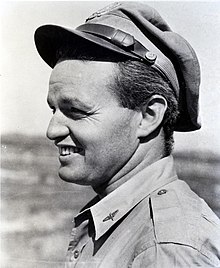Philip Cochran
| Philip Gerald Cochran | |
|---|---|

Colonel Philip Cochran, USAAF, in 1944.
|
|
| Born |
January 29, 1910 Erie, Pennsylvania |
| Died | August 26, 1979 (aged 69) Geneseo, New York |
| Allegiance |
|
| Service/branch |
U.S. Army Air Corps (1935–1941) U.S. Army Air Forces (1941–1945) |
| Years of service | 1935—1945 |
| Rank | Colonel |
| Commands held | 1st Air Commando Group |
| Battles/wars | |
| Awards |
Distinguished Service Medal Distinguished Service Order (UK) Distinguished Flying Cross Croix de Guerre (France) |
Philip Gerald Cochran (born in Erie, Pennsylvania January 29, 1910 – August 26, 1979) was an officer in the United States Army Air Corps and the United States Army Air Forces. Cochran developed many tactical air combat, air transport, and air assault techniques during the war, particularly in Burma during operations as co-commander (with Col John R. Alison) of the 1st Air Commando Group. Cochran was the inspiration behind characters in the Terry and the Pirates and Steve Canyon by Milton Caniff.
After earning a business degree from Ohio State University in 1935. Cochran enlisted as a pilot in the Army Air Corps because "it looked like a good way to make an easy living."
Cochran had known Milton Caniff at Ohio State and approached him in 1941 to design an insignia for his 65th Fighter Squadron (predecessor of the modern 65th Aggressor Squadron.) After watching Cochran's squadron, Caniff thought Cochran and his squadron had potential as characters for comics. Cochran became famous during the war as the model for the character Flip Corkin, a character in the comic strip Terry and the Pirates. Later on in life, Cochran became the model for another character in the Caniff comic strip Steve Canyon. Cochran's character was named General Philerie; a combination of his first name, Phil, and his hometown, Erie.
Major Cochran led the 33rd Fighter Group's "advanced attrition" fighter planes and replacement pilots to the North African campaign. His men called themselves the "Joker Squadron" because the squadron had been designated as "J Squadron" in the plan for the landings in North Africa. In December, 1942 he took the 58th Fighter Squadron into the advanced airfield at Thelepte, an airfield in western Tunisa that had been captured by advancing French troops. His Deputy Commander called him “a colorful individual, a natural leader. "He was aggressive, but not ambitiously so". Cochran soon found himself mentioned in press reports. While flying from Thelepte, Cochran dropped a 500-pound bomb that skipped directly into the German headquarters at the Hotel Splendida, Kairouan, Tunisia. He destroyed telegraph wires by flying over them with a lead weight on the end of a wire attached to the wing of his pursuit plane, a tactic he would employ later in Burma. By the end of hostilities in the theater, he had shot down two German fighter planes.
...
Wikipedia
